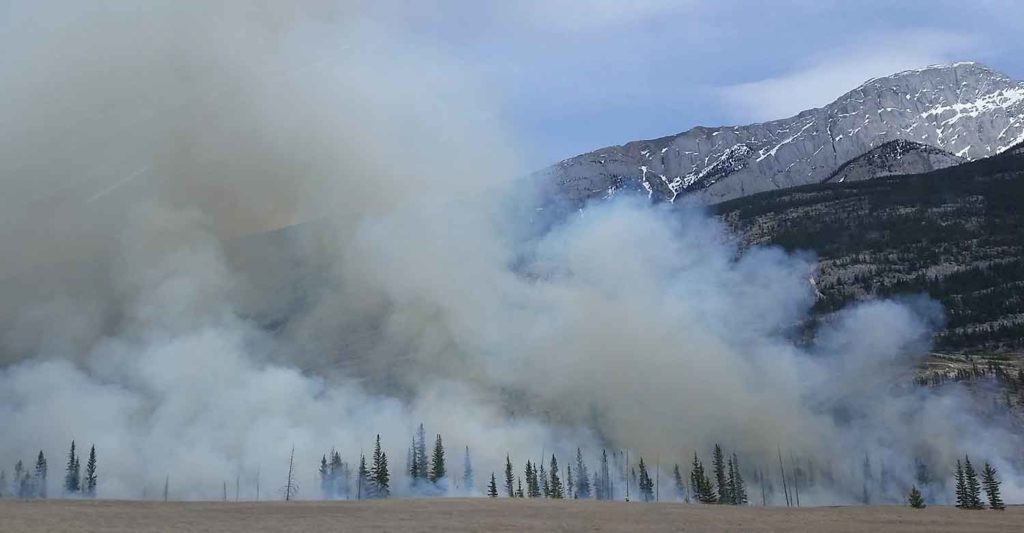
Events in 2020 have spotlighted two significant concerns regarding indoor air quality. A particularly bad wildfire season combined with the COVID-19 pandemic have raised awareness of the role air quality has to play in overall health and how HVAC systems can improve that air quality.

Small Particles, Big Dangers
The smallest particles carry the greatest dangers. In the case of smoke, it is those smaller than 10 microns, a fraction of the width of a human hair, that can travel the farthest and enter the lungs and the bloodstream. An inflammatory reaction from these particles can problems with breathing as well as pneumonia, bronchitis, strokes and heart attacks. Pregnant women may face a particular risk of having a child with a low birth weight or prematurely. Others at higher risk from smoke-related issues include:
- older adults, possibly because of a higher likelihood of developing lung or heart disease
- children, whose developing airways mean they breathe more air in for each pound of body weight than adults do
- people with asthma or other lung issues or those who have heart disease
Medical professionals have also emphasized that it is very small particles that create risk for transmitting COVID-19 as well. Other small particles that are simply part of the air even in non-pandemic times can be hazardous, and one study found that nearly three-fourths of homes had these particles.
Other Dangers
When outside air quality becomes dangerous because of wildfire smoke, it is prudent to keep windows closed. However, this does potentially create other problems because closing the windows prevents regular air exchange.
People who are forced to stay indoors and close windows because of the danger of wildfire smoke may face increased dangers from indoor pollutants, including cigarette smoke and gas stove usage. Vacuum cleaners without HEPA filters will further stir up and disturb particles.

COVID-19 has created air quality challenges for families staying home. Houses are increasingly constructed to be airtight, but this means that a majority of homes have insufficient ventilation. While the purpose is to keep humidity down, when entire families and pets are at home around the clock on a daily basis, too much humidity is generated, and this could increase the incidence of biogrowth.
When people are at home more, they also clean more, particularly since they are more concerned about cleanliness to reduce the spread of COVID-19. This can mean more chemicals are in use, which also contributes to lower air quality in the home.
The popularity of ductless mini-splits creates an additional challenge. While these systems offer a number of advantages for heating and cooling, filtration is limited, leading to the need for more complex solutions.
The Role of HVAC Companies
For people who normally rely on the airflow of open windows and doors to keep their homes cool in the warmer months, having to close everything up because of wildfire smoke can lead to unacceptably hot interiors that could be dangerous to health or even life-threatening. Older people are particularly vulnerable to heat-related illnesses, and they may want to have an air conditioning unit installed.
Germicidal UV lights could be installed by HVAC contractors to reduce biogrowths that flourish when there is too much humidity.
HVAC professionals can help install systems that will protect against many of these issues exacerbated by wildfire smoke and COVID-19, but there are additional issues to be addressed of professional education and consumer trust.
Efforts on the part of manufacturers to educate HVAC professionals about indoor air quality and the options that are available have been popular. These include virtual meetings and webinars. Customers are interested in what options are available to keep their homes safer, but accuracy of information is critical.
As an example, anti-microbial products used in ducts cannot kill viruses. However, they can discourage overall biogrowth. HVAC professionals must be able to accurately convey the risks and solutions to customers without spreading misinformation. Performing indoor air quality analysis as part of a consultation can be an important part of this.
Customer Concerns
Several other factors are converging to complicate issues around HVAC installation and safety. A struggling economy means consumers simply do not have as much disposable income, and some of the highest-quality installations can be expensive.

However, customers are increasingly interested in what they can do to maintain their indoor air quality, and they are not averse to spending money to do it. The challenge for HVAC professionals is to both educate and sell. Customers must accurately understand what HVAC systems can and cannot do to protect them.
Solutions
Talking to an HVAC professional is important because they will be able to assess a customer’s particular needs based on the layout of their home, their existing system , their indoor air quality and their lifestyle. Solutions include
- a fresh air filter with a high Minimum Efficiency Reporting Value and activated carbon for central air systems to reduce particulates
- a two-stage catechin filter for ductless heat pumps to trap viruses, bacteria, particulates and germs
- a heat recovery ventilator or electrostatic whole home air filter
- keeping the fan on at the thermostat for heating or cooling systems not in use
How a Telephone Answering Service Can Help
With winter approaching, COVID-19 concerns are on the rise, and homeowners may also be looking with trepidation toward the next fire season. Customers who might previously have been largely concerned with how effective and efficient an HVAC system would be may now have serious anxieties about the safety and health of themselves and their families.
An answering service to screen calls can be a reassuring first point of contact for these worried customers. Being able to talk to trained, compassionate individuals who know the best way to handle their call and put them on track for the right solution can solidify customer confidence.
